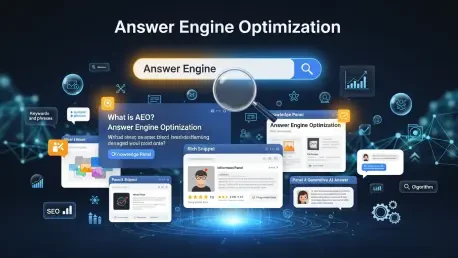The digital landscape has undergone a seismic shift with the rise of generative AI, and businesses are grappling with a startling reality: over 60% of online queries are now answered directly by AI chatbots rather than traditional search engine results pages. Imagine a potential customer asking a chatbot for recommendations, only to find that a competitor’s brand is mentioned first—simply because they adapted to this new era while others lagged behind. This scenario underscores the urgent need for Answer Engine Optimization (AEO), a strategy designed to ensure that a business’s content is the go-to response for AI-driven queries. This guide aims to equip businesses with actionable steps to enhance online visibility in an AI-dominated world, offering a competitive edge in reaching target audiences effectively.
AEO represents a pivotal adaptation to how information is accessed today, moving beyond traditional search engine optimization to address the nuances of conversational AI interactions. The importance of mastering this approach cannot be overstated, as it directly impacts a brand’s ability to remain relevant when consumers rely on tools like chatbots for instant answers. This comprehensive guide explores the transformative power of AEO, detailing strategies to optimize digital presence and ensure content resonates with both users and AI systems.
The purpose of this guide is to provide a clear roadmap for businesses looking to navigate the complexities of AI-driven search environments. By focusing on practical, step-by-step tactics, it addresses the challenges of standing out in a crowded digital space where visibility is no longer just about ranking on a search engine but about being the authoritative answer in a chatbot’s response. Readers will gain insights into building a robust online foundation, creating impactful content, and leveraging technical tools to stay ahead of the curve.
Unveiling the Power of Answer Engine Optimization
In today’s digital marketing arena, Answer Engine Optimization emerges as a game-changer, driven by the rapid advancements in generative AI technology. This strategy focuses on optimizing content to be readily accessible and relevant for AI chatbots, which have become primary sources of information for millions of users worldwide. As these tools shape consumer behavior by delivering direct answers, businesses that fail to adapt risk fading into obscurity, while those embracing AEO can secure a significant competitive advantage.
The urgency to adopt AEO stems from the shift in how information is consumed, with chatbots often bypassing traditional search results to provide instant responses. This transformation demands a new approach to visibility, one that prioritizes being the source of truth for AI systems. Companies that invest in this strategy position themselves as trusted authorities, ensuring their brand is front and center when users seek answers through conversational interfaces.
This guide delves into critical AEO strategies that can elevate a business’s online presence, from aligning content with user intent to enhancing technical frameworks for AI accessibility. Readers will uncover methods to build a strong digital foundation, optimize for conversational queries, and expand reach across multiple platforms. Each aspect is designed to maximize visibility in an era where AI dictates much of the information flow, offering a clear path to sustained relevance.
The Shift from SEO to AEO: Why It Matters
Digital marketing has evolved dramatically over recent years, transitioning from a sole focus on Search Engine Optimization (SEO) to incorporating Answer Engine Optimization and Generative Engine Optimization (GEO). This shift reflects the growing influence of AI-driven search tools that have redefined user interactions since their widespread adoption. Businesses must now consider how these technologies alter the way audiences discover information, moving beyond traditional search rankings to direct, conversational answers.
The impact of AI on user behavior is profound, as consumers increasingly turn to chatbots for quick, concise responses rather than sifting through pages of search results. This shift necessitates an adaptation in optimization strategies to ensure content is not only visible on search engines but also prioritized by AI systems for instant delivery. Ignoring this trend risks losing market share to competitors who have embraced the new landscape of information retrieval.
Contrary to some misconceptions, SEO is far from obsolete; rather, it serves as a complementary foundation to AEO. While traditional tactics remain essential for organic search visibility, integrating AEO ensures a business’s content aligns with the conversational nature of AI interactions. This dual approach is vital for maintaining relevance in a tech-driven environment, blending established practices with innovative methods to capture a wider audience.
Key Strategies for Mastering Answer Engine Optimization
Step 1: Building a Strong Website Foundation
A well-structured, branded website stands as the cornerstone of any effective AEO strategy. It acts as a central hub for storytelling, product information, and customer engagement, providing a reliable source of data that AI chatbots can draw upon when answering user queries. Without a solid online presence, even the most compelling content may go unnoticed by AI systems scanning for authoritative information.
Investing in a website that reflects brand identity and offers comprehensive details about services or products is crucial for establishing a strong online presence. This digital space should not only attract human visitors but also serve as a rich repository for AI to reference, increasing the likelihood of being featured in chatbot responses. A strong foundation ensures that all other optimization efforts have a stable platform to build upon.
Ensuring Accessibility and Usability
Accessibility and usability are paramount for a website to appeal to both users and AI systems. Intuitive navigation, fast loading times, and mobile-friendly design are non-negotiable elements that enhance user experience while making content easier for AI to parse. A site that is difficult to navigate or slow to load risks losing visibility in both human and automated searches.
Beyond basic functionality, ensuring that the website adheres to accessibility standards broadens its reach to diverse audiences. This includes features like alt text for images and clear, logical site architecture. Such considerations signal to AI tools that the content is user-focused, thereby boosting the chances of being prioritized in responses to relevant queries.
Crafting a Data-Rich Repository
Creating a data-rich website involves populating it with detailed, organized content that addresses a wide range of user needs. This means including in-depth articles, FAQs, and product descriptions that provide comprehensive answers to potential questions. The more relevant information available, the higher the likelihood that AI chatbots will source from this repository.
Organizing content with clear categories and internal linking further aids AI in understanding the site’s structure and relevance. This systematic approach ensures that specific pages are easily discoverable for niche queries, enhancing overall visibility. A well-maintained content library becomes a powerful asset in the AEO arsenal.
Step 2: Prioritizing User-Centric Content Creation
High-quality content tailored to user intent is at the heart of AEO, especially for conversational queries posed to AI chatbots. Understanding what users are likely to ask and crafting responses that directly address those needs can significantly improve visibility. This user-centric focus ensures that content resonates with both the audience and the algorithms interpreting their requests.
Balancing AI-generated content with human oversight is essential to maintain authenticity and accuracy. While automation can streamline content production, human editors must verify facts and refine tone to align with brand voice. This hybrid approach prevents errors and builds trust, a critical factor in how AI evaluates content for relevance.
Aligning with Conversational Queries
Content should reflect the natural language patterns that users adopt when interacting with AI chatbots. This means anticipating questions asked in a conversational tone, such as “What are the best tools for small businesses?” and crafting responses that feel direct and personal. Keyword stuffing should be avoided in favor of natural, engaging dialogue.
Analyzing common query formats through tools like search analytics can provide valuable insights into phrasing and user intent. Structuring content to answer these queries explicitly, often in a question-and-answer format, increases the likelihood of being selected by AI systems as the authoritative response. This alignment with conversational style is a key differentiator in Answer Engine Optimization (AEO).
Upholding EEAT Standards
Adhering to Experience, Expertise, Authoritativeness, and Trustworthiness (EEAT) standards is vital for content credibility in the eyes of AI algorithms. Demonstrating deep knowledge through well-researched material, citing credible sources, and showcasing author credentials can elevate a brand’s standing, as these elements signal reliability to both users and automated systems.
Transparency in content creation, such as disclosing affiliations or providing verifiable data, further reinforces trustworthiness. Regularly updating information to reflect current trends or corrections ensures sustained authority. Commitment to EEAT principles positions content as a preferred choice for AI-driven answers.
Step 3: Leveraging Technical Optimization Tools
Technical optimization plays a critical role in making content accessible to AI systems, ensuring it is easily interpreted and prioritized. Tools like structured data and specific file configurations help bridge the gap between human-readable content and machine-understandable data. This technical layer is often overlooked but is indispensable for AEO success.
Implementing these tools requires a foundational understanding of how AI crawls and indexes information. By enhancing the backend structure of a website, businesses can improve the chances of their content being pulled for relevant queries. This step focuses on precision and compatibility with AI processing mechanisms.
Implementing Schema Markup
Schema markup, such as FAQ Schema or LocalBusiness Schema, provides a standardized way to label content, making it clearer for AI bots to interpret. This structured data helps highlight key information like business hours, frequently asked questions, or product details, directly influencing how answers are formatted in chatbot responses.
Incorporating schema markup involves adding specific code to a website’s HTML, often through content management system plugins or manual integration. Testing and validating this markup using available online tools ensures accuracy and effectiveness. Such technical enhancements can significantly boost visibility in AI-driven searches.
Utilizing LLMS.txt Files
LLMS.txt files serve as guides for AI robots, directing them to the most relevant data on a website, and similar to robots.txt files used for traditional search engines, these configurations help prioritize content for generative AI systems. This ensures that critical information is not overlooked in the process. This emerging practice is gaining traction in AEO.
Setting up an LLMS.txt file involves specifying paths to high-value content and excluding irrelevant sections, ensuring that the most important information is prioritized. Regular updates to reflect changes in website structure or priorities are essential to maintain its effectiveness. This tool offers a direct line of communication with AI systems, enhancing content discoverability.
Step 4: Enhancing Credibility with Reviews and Citations
Currently, high-quality reviews across various platforms play a substantial role in building trust and visibility for AEO. Positive feedback from customers validates a business’s credibility, influencing both user decisions and AI evaluations of reliability. Actively managing reviews is a proactive step toward establishing a trustworthy online reputation.
Consistent citations in reputable directories further amplify this trust by ensuring accurate and widespread brand information, which is crucial for online visibility. These elements collectively reinforce a business’s legitimacy, making it more likely to be recommended by AI chatbots. Credibility remains a cornerstone of digital success in this context.
Managing Multi-Platform Reviews
Maintaining active review profiles on platforms beyond just a primary business listing, such as industry-specific sites or social media, significantly expands reach and impact. Encouraging satisfied customers to share their experiences and promptly addressing negative feedback demonstrates responsiveness. This multi-platform approach signals a robust online presence to AI systems.
Monitoring and responding to reviews regularly keeps the profile dynamic and relevant, a factor AI tools often consider when assessing credibility. Aggregating feedback across channels also provides valuable insights into customer sentiment, which can inform content strategies. A comprehensive review strategy is indispensable for AEO.
Ensuring Accurate NAP Data
Ensuring accurate Name, Address, and Phone (NAP) data is crucial for businesses aiming to improve their online visibility and local search rankings, as inconsistencies in this information can significantly harm a company’s credibility and customer trust. Incorrect or outdated NAP data can confuse potential customers and negatively impact search engine optimization efforts. Therefore, businesses must regularly audit and update their NAP information across all online platforms, directories, and websites. This consistent approach helps maintain a strong digital presence and ensures that customers can easily find and contact the business.
Consistency in Name, Address, and Phone Number (NAP) data across online directories is critical for local visibility and trust. Discrepancies can confuse AI systems and users alike, potentially lowering a business’s ranking in local search results. Regular audits of NAP information in key listings prevent such issues.
Utilizing tools to automate updates and flag inconsistencies streamlines this process, ensuring uniformity across the web. Accurate NAP (Name, Address, Phone) data not only aids in local SEO but also enhances user confidence in the business’s legitimacy. Precision in this area is a fundamental aspect of optimization.
Step 5: Expanding Digital Presence Across Platforms
A comprehensive AEO strategy extends beyond a website to include a strong presence on social media, video platforms like YouTube, and alternative search engines such as Bing. Diversifying digital touchpoints increases the chances of being discovered by AI-driven searches across varied user contexts, ensuring that your content reaches a wider range of potential viewers. This holistic approach captures a broader audience.
Each platform offers unique opportunities to engage with users and reinforce brand messaging, which AI systems can reference when formulating responses. Expanding reach across these channels ensures that a business remains visible regardless of where or how a query originates. This multifaceted presence is a key driver of AEO success.
Engaging on Social Media
Social media platforms provide a dynamic space to amplify brand voice and connect with AI-influenced audiences. Regular posting, interactive content, and community engagement build a vibrant online identity that chatbots can draw from when answering user questions. Consistency and authenticity are crucial in this arena.
Tailoring content to platform-specific trends and user behaviors maximizes impact, ensuring relevance in AI scans. Leveraging analytics to refine social strategies further enhances effectiveness, aligning posts with popular queries or topics. Social engagement becomes a powerful tool for boosting AEO outcomes.
Optimizing for Bing and Beyond
While much focus often centers on a single dominant search engine, Bing’s integration with major AI chatbots presents untapped potential for visibility. Optimizing content for Bing through tailored keywords and technical adjustments can yield significant returns in AI-driven search results. This challenges the narrow focus of many optimization efforts.
Exploring other emerging platforms and their AI integrations also prepares a business for evolving trends in search behavior, ensuring adaptability to new tools and algorithms. Staying adaptable to these innovations is crucial for maintaining long-term relevance in a competitive digital space. Broadening optimization horizons is a forward-thinking AEO strategy.
Summarizing the Core AEO Strategies
This section consolidates the essential tactics for Answer Engine Optimization into a concise list for quick reference, ensuring businesses can easily revisit the key actions needed to enhance visibility.
- Build a robust, user-friendly website as the foundation for all digital efforts.
- Create high-quality, user-intent-driven content with careful human oversight.
- Use structured data and technical tools to improve AI accessibility and interpretation.
- Maintain credible reviews and consistent citations across multiple platforms.
- Expand presence on social media, YouTube, and alternative search engines like Bing.
AEO in the Broader Digital Landscape: Future Trends
Answer Engine Optimization fits seamlessly into the larger tapestry of digital marketing trends, reflecting the growing reliance on generative AI to shape consumer interactions. As these technologies continue to evolve, their influence on how information is accessed will deepen, impacting industries from retail to professional services. Staying attuned to these shifts is essential for sustained visibility.
Challenges such as maintaining content authenticity in an era of AI-generated material loom large, requiring businesses to prioritize transparency and human input. Additionally, the integration of AI into more search tools and platforms suggests a future where adaptability becomes a core competency. Preparing for these developments positions a company to navigate potential disruptions effectively.
Looking ahead, AEO is not a fleeting trend but a long-term investment in digital relevance. Industries must anticipate further personalization in AI responses and explore ways to tailor content even more precisely to user needs. Viewing this strategy as an ongoing commitment ensures that businesses remain agile in a rapidly changing technological landscape.
Taking the Next Step with Answer Engine Optimization
Reflecting on the journey through AEO, it became evident that this strategy had transformed the approach to online visibility for many businesses. The actionable steps outlined had provided a robust framework to stand out in an AI-driven digital age, ensuring content was prioritized by chatbots and reached target audiences effectively.
As a next step, integrating AEO with existing SEO efforts has proven to be a seamless way to amplify results, blending traditional strengths with innovative tactics. Partnering with expert services for streamlined implementation has also emerged as a practical solution for those navigating this complex terrain. Businesses are encouraged to begin optimizing their digital presence immediately, capitalizing on the competitive advantage and sustained relevance that AEO offers.
Looking beyond immediate actions, exploring emerging AI tools and platforms has opened new avenues for engagement and visibility. Continuous learning and adaptation to user behavior trends have positioned companies to anticipate future shifts in the digital landscape. Embracing these forward-thinking considerations has ensured that the benefits of AEO extend well into the long term, securing a lasting impact on brand presence.









